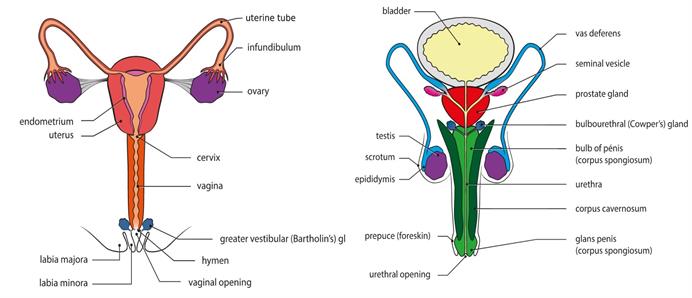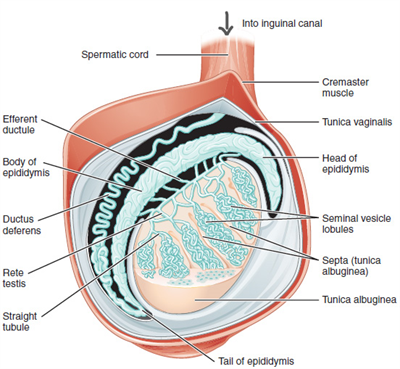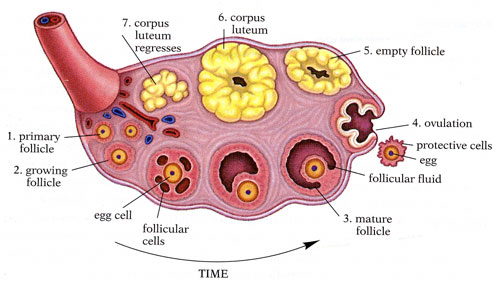PDF chapter test TRY NOW
The gonads are the sex glands which are of two types:
1. Testes
2. Ovaries
The testes are present in males, while the ovaries are present in females. They produce sperms and ova, respectively.

Female and male reproductive system
Testes:
Testes are the reproductive glands of males. A pair of testes is situated in the scrotum of a male.
Testes are composed of seminiferous tubules, interstitial cells or Leydig cells and Sertoli cells.
The Leydig cells form the endocrine part of the testes. These cells secrete the male sex hormone called androgens. The primary androgen is testosterone.

Male gonad - Testis
Functions of testosterone:
1. It stimulates the growth and development of secondary sex organs like seminal vesicles, penis and prostate.
2. Testosterone influences the process of spermatogenesis (formation of sperms in the seminiferous tubules of testes).
3. The hormone stimulatesprotein synthesis and controls muscular growth.
4. Testosterone stimulates the development of secondary sexual characters (distribution of hair on body and face, low-pitched and deep voice pattern, etc.).
5. The hormone promotes the growth of body tissues such as muscles and bones.
Ovary:
In females, the ovaries are present in the pelvic cavity of the abdomen.
They are the female gonads that secrete the female sex hormones that include:
a. Estrogen - secreted by the Graafian follicles of the ovary
b. Progesterone - secreted by the corpus luteum, which is formed in the ovary from the ruptured follicle during ovulation
c. Relaxin - secreted by corpus luteum during the later stages of pregnancy
d. Inhibin/ Actin - secreted by the corpus luteum. The inhibin hormone inhibitsFSH and GnRH production, while actinactivatesFSH and GnRH production.

Female gonad - Ovary
Functions of Estrogen:
1. Estrogen brings about the changes which occur during puberty.
2. Estrogen initiates the process of oogenesis.
3. It is the principal feminizing hormone that stimulates the maturation of ovarian follicles in the ovary.
4. It stimulates the development of female secondary sexual characters (breast development, high pitched voice etc.).
Functions of Progesterone:
1. Progesterone is responsible for the premenstrual changes that take place in the uterus.
2. It prepares the uterus for the implantation of the embryo.
3. It is required for the formation of the placenta.
4. Progesterone is also required for the maintenance of pregnancy.
Reference:
https://upload.wikimedia.org/wikipedia/commons/c/ca/Female_genital_system_-_Front_view_1.svg
https://upload.wikimedia.org/wikipedia/commons/c/cf/Male_genital_system_-_Front_view.svg
https://upload.wikimedia.org/wikipedia/commons/3/32/Anatomy_of_the_ovaries.jpg
https://upload.wikimedia.org/wikipedia/commons/5/55/Figure_28_01_03.JPG
